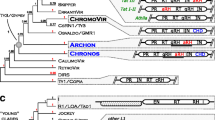Abstract
An interspersed sequence has been isolated from the genome of D. silvestris, a species endemic to the Hawaiian Islands. The LOA element is 7.7 kb long and its 3′ end consists of (TAA)n tandem repeats. Five different LOA elements were isolated, of which three were truncated at their 5′ ends. Large deletions within the elements were frequent. A consensus sequence of the LOA element has been constructed using the nucleotide sequence of three elements. Two overlapping open reading frames (ORF) are present in the LOA element. In ORF1 two ‘cys’ motifs characteristic for gag proteins are found. The protein translated from ORF2 has similarities with retroviral pol genes. A protein databank search revealed 22% to 25% identity with the reverse transcriptase domains of retrotransposons. This region also shows the pattern of invariant amino acid residues which are most conserved in retroviral reverse transcriptases. In ORF2 an integrase specific ‘cys’ motif and a conserved sequence of retroviral proteases were identified. Structural similarities with LINE-like elements suggest that the LOA element represents a new non-LTR retrotransposon.
The DNA sequences of the LOA elements 5.I, 5.II 10 and the consensus sequence have been submitted to the EMBL data library with accession numbers X60174, X60175, X60176 and X60177 respectively.
Similar content being viewed by others
References
BesanskyN., 1990. A retrotransposable element from the mosquito Anopheles gambiae. Mol. Cell. Biol. 10: 863–871.
CabotE. L. & BeckenbachA. T., 1989. Simultaneous editing of multiple nucleic acid and protein sequences with ESEE. Computer Applications in the Biosciences 5: 233–234.
DiNoceraP. P. & CasariG., 1987. Related polypeptides are encoded by Drosophila F elements, I factors and mammalian L1 sequences. Proc. Natl. Acad. Sci. USA 84: 5843–5847.
DiNoceraP. P., GrazianiF. & LarvornaG., 1986. Genomic and structural organisation of Drosophila melanogaster G elements. Nucleic Acids Res. 14: 675–691.
FanningT. G. & SingerM. F., 1987. LINE-1: a mammalian transposable element. Biochim. Biophys. Acta 910: 203–212.
FawcettD. H., ListerC. K., KellettE. & FinneganD. J., 1986. Transposable elements controlling I-R hybrid dysgenesis in D. melanogaster are similar to mammalian LINEs. Cell 47: 1007–1015.
HenikoffS., 1985. Unidirectional digestion with exonuclease III creates targeted breakpoints for DNA sequencing. Gene 28: 351–359.
HuntJ. A., BishopIIIJ. G. & CarsonH. L., 1984. Chromosomal mapping of a middle-repetitive DNA sequence in a cluster of five species of Hawaiian Drosophila. Procl. Natl. Acad. Sci. USA 81: 7146–7150.
HutchisonIIIC. A., HardiesS. C., LoebD. D., SheheeW. R. & EdgellM. H., 1989. LINEs and related retroposons: Long interspersed repeated sequences in the eukaryotic genome. pp. 593–617. In: Mobile DNA, edited by D. E.Berg, and M. M.Howe. American Society for Microbiology, Washington D. C.
JakubczakJ. L., XiongY. & EickbushT. H., 1990. Type I (R1) and type II (R2) ribosomal DNA insertions of Drosophila melanogaster are retrotransposable elements closely related to those of Bombyx mori. J. Mol. Biol. 212: 37–52.
KimmelB. E., ole-MoiyoiO. K. & YoungJ. R., 1987. Ingi a 5.2 kilobase dispersed sequence element from Trypanosoma brucei. Mol. Cell. Biol. 7: 1465–1475.
KozakM., 1986. Point mutations define a sequence flanking the AUG initiation codon that modulates translation by eukaryotic ribosomes. Cell 44: 283–292.
LoebD. D., PadgettR. W., HardiesS. C., SheheeW. R., ComerM. B., EdgellM. H. & HutchisonIIIC. A., 1986. The sequence of a large L1Md element reveals a tandemly repeated 5′ end and several features found in retrotransposons. Mol. Cell. Biol. 6: 168–182.
MarckC., 1986. Fast analysis of DNA and protein sequence on the Apple IIe: Restriction sites search, alignments of short sequences and dot matrix analysis. Nucleic Acids Res. 14: 583–590.
MeadD. A. & KemperB., 1988. Chimeric single-stranded DNA phage-plasmid cloning vectors. pp. 85–102. In: Vectors—A Survey of Molecular Cloning Vectors and their Uses, edited by R. L.Rodriguez, and D. T.Denhardt, Butterworths Publishers Boston, M. A.
PearlL. H. & TaylorW. R., 1987. A structural model for the retroviral proteases. Nature 329: 351–354.
PearsonW. R. & LipmanD. J., 1988. Improved tools for biological sequence comparison. Proc. Natl. Acad. Sci. USA 85: 2444–2448.
PriimaegiA. F., MizrokhiL. J. & IlynY. V., 1988. The Drosophila mobile element jockey belongs to LINEs and contains coding sequences homologous to some retroviral proteins. Gene 70: 253–262.
SangerF., NicklenS. & CoulsonA. R., 1977. DNA sequencing with chain-terminating inhibitors. Proc. Natl. Acad. Sci. USA 74: 5463–5467.
TohH., KikunoR., HayashidaH., MiyataT., KugimiyaW., InouyeS., YukiS. & SaigoK., 1985. Close structural resemblance between putative polymerase of a Drosophila transposable genetic element 17.6 and pol gene product of Moloney murine leukemia virus. EMBO J. 4: 1267–1272.
VarmusH. & BrownP., 1989. Retroviruses. pp. 53–108. In BergD. and HoweM. (eds.), Mobile DNA, edited by D. E. Berg, and M. M. Howe. American Society for Microbiology, Washington D. C.
XiongY. & EickbushT. H., 1988. The site-specific ribosomal DNA insertion element R1Bm belongs to a class of non-longterminal-repeat retrotransposons. Mol. Cell. Biol. 8: 114–123.
Author information
Authors and Affiliations
Rights and permissions
About this article
Cite this article
Felger, I., Hunt, J.A. A non-LTR retrotransposon from the Hawaiian Drosophila: the LOA element. Genetica 85, 119–130 (1992). https://doi.org/10.1007/BF00120318
Received:
Accepted:
Issue Date:
DOI: https://doi.org/10.1007/BF00120318




